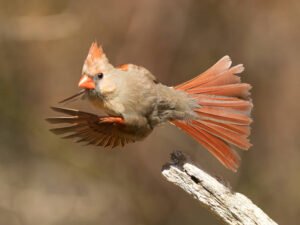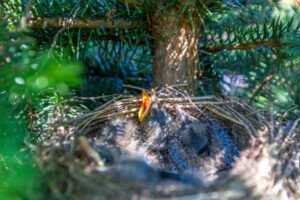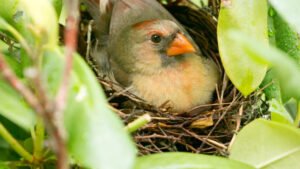
The lifespan of female Cardinals, vibrant and iconic birds known for their striking red plumage, is a topic that captivates bird enthusiasts and nature lovers alike. “How Long do Female Cardinals Live” delves into the intricacies of the life expectancy of these avian creatures, shedding light on the factors that influence their longevity and the fascinating aspects of their life cycle.
Female Cardinals, with their distinctive reddish hues contrasting against a predominantly brown and green environment, are integral members of the bird community. This exploration aims to unravel the mysteries surrounding their lifespan, examining the impact of environmental conditions, habitat choices, and the challenges they face in natural and human-altered landscapes. Understanding the lifespan of female Cardinals provides valuable insights into their resilience and adaptability in the face of changing ecological dynamics.
Beyond the aesthetic appeal of these feathered creatures, their longevity is a vital indicator of the overall health and sustainability of the ecosystems they inhabit. By unraveling the secrets of their lifespan, we gain a deeper appreciation for the delicate balance of nature and the interconnected web of life. This inquiry also paves the way for discussions on conservation efforts and the importance of preserving habitats to ensure the continued well-being of female Cardinals and their avian counterparts.
As we embark on this exploration into the temporal dimension of female Cardinals’ lives, we invite you to join us in unraveling the tapestry of their existence, discovering the factors that shape their lifespans, and ultimately gaining a richer understanding of these remarkable birds that grace our landscapes with their beauty and resilience.
Introduction of Female Cardinal Life
The lifespan of female Cardinals, those shining ambassadors of the avian world, is a subject that beckons enthusiasts and ornithologists alike into the heart of the intricate tapestry of nature. In the following exploration, we embark on a journey to unveil the mysteries surrounding the longevity of female Cardinals, iconic for their vibrant red plumage that stands out against the canvas of the natural world. “How Long do Female Cardinals Live” aims to provide a comprehensive overview of the factors influencing their lifespan, weaving together the threads of biology, environment, and conservation.

At first glance, the female Cardinal may captivate observers with its striking appearance, its subdued yet elegant reddish tones juxtaposed against a backdrop of green foliage. However, beneath this aesthetic allure lies a complex web of biological and ecological considerations that shape their lives. As we delve into this exploration, we seek to answer the titular question and unravel the broader narrative of the female Cardinal’s existence.
Female Cardinals, belonging to the Cardinalidae family, are essential components of North American ecosystems, renowned for their distinctive appearance and melodic songs. These birds, characterized by their crested heads and robust beaks, are distributed across various habitats, from woodlands and suburban gardens to brushy thickets. The intricacies of their lives, from nesting behaviors to dietary preferences, are intertwined with the broader ecological systems they inhabit.
The inquiry into the lifespan of female Cardinals is not merely an exercise in avian demographics; it is a gateway to understanding the delicate equilibrium that sustains biodiversity. In all its complexity, nature has bestowed upon these creatures a specific temporal framework within which they navigate the challenges of survival, reproduction, and adaptation. By peeling back the layers of their existence, we gain insights into the pulse of the ecosystems they inhabit, the interdependence of species, and the profound influence of environmental variables.
As we embark on this odyssey into the realm of female Cardinal life, it becomes evident that their existence is a testament to nature’s artistry and efficiency. Each aspect of their biology, from their plumage coloration to their choice of nesting sites, has evolved as a response to the demands of their environment. The journey to unravel the secrets of their lifespan is a journey into the heart of evolutionary processes that have sculpted these birds into the marvels of adaptation we see today.
Moreover, the lifespan of female Cardinals serves as a barometer for the health of the ecosystems they inhabit. In an era marked by environmental shifts and human-induced changes, understanding the temporal dimensions of their lives is not just a scientific pursuit but a clarion call for conservation. Female Cardinals, as key players in intricate ecological webs, reflect the overall well-being of habitats and ecosystems. Their longevity is, in many ways, a reflection of the sustainability and resilience of the natural world.
In the following chapters, we will explore the diverse factors contributing to female Cardinals’ lifespan. From the genetic underpinnings that dictate their life expectancy to the environmental challenges that shape their daily existence, each facet adds a layer to the narrative of these feathered denizens of the wild. Our quest is to quantify their lifespan, understand the nuanced dance between biology and ecology, and appreciate the multifaceted roles female Cardinals play in the grand theater of nature.
Female Cardinal Life 1st Stage
The life of a female Cardinal begins in the delicate realm of the nest, where the cycle of existence commences with the hatching of chicks. Understanding the early stages of a baby female Cardinal’s life is akin to deciphering the opening chapters of a compelling narrative that unfolds against the backdrop of nature’s theater. Upon hatching, female Cardinal chicks emerge as featherless, blind entities, entirely dependent on the care and provision of their parents. The initial days are marked by the mother and father Cardinals’ tender efforts in ensuring their offspring’s survival and well-being. The nurturing instinct kicks in as the parents meticulously attend to the demands of their brood, providing warmth, protection, and sustenance.

Feeding predominantly on a diet of insects and seeds regurgitated by their parents, baby female Cardinals undergo rapid growth and development. The feathering process begins, transforming the initially bald hatchlings into miniature versions of the vibrant adults they are destined to become. The intricate patterns of their future plumage emerge, a precursor of the striking red hues that distinguish the females in their mature state.
As they progress through the fledgling stage, baby female Cardinals experience a steep learning curve. Their parents play a pivotal role in this educational journey, teaching essential skills such as foraging, identifying potential threats, and perfecting the art of flight. The nest serves as a classroom, a haven where these fledglings can hone the abilities crucial for survival in the wild. The fledgling phase has its challenges. The vulnerability of these young Cardinals makes them susceptible to predation, adverse weather conditions, and other environmental hazards. During this stage, the mortality rate can be relatively high, emphasizing the significance of a stable and secure environment for their development.
As the days progress, the once-dependent chicks become more independent, gradually exploring the surroundings beyond the confines of the nest. The transition from reliance on parental care to self-sufficiency marks a critical juncture in their early lives. During this period, the distinctive features that define the female Cardinals, including their plumage coloration, become increasingly apparent. The fledgling phase ultimately culminates in the young female Cardinals achieving complete independence. They disperse into the surrounding habitat, navigating the complexities of the environment on their own. The success of this stage is a testament to the resilience and adaptability ingrained in their genetic makeup, as well as the efficacy of parental guidance and protection.
In unraveling the story of baby female Cardinals, we gain a glimpse into the vulnerability and charm of their formative days and a profound appreciation for the intricate processes that shape their journey from hatchling to independent avian beings. The fledgling stage lays the foundation for the subsequent chapters of their lives, setting the stage for the myriad experiences that define their existence in the broader tapestry of the natural world.
Female Cardinal Life 2nd Stage
As the fledgling female Cardinals mature into adulthood, a transformation accentuates the beauty and vitality for which these birds are celebrated. The development of distinctive features marks the second stage of a female Cardinal’s life, the establishment of territories and the onset of reproductive responsibilities.

One of the most conspicuous aspects of adult female Cardinals is their striking plumage. The once-muted hues of their youth evolve into the iconic red tones that make them stand out amidst the foliage. This transformation is not merely an aesthetic spectacle; it plays a crucial role in the intricate dance of courtship and communication. The vibrant colors serve as visual signals, allowing individuals to convey information about their health, genetic fitness, and readiness to mate.
As adults, female Cardinals actively participate in establishing and defending territories. Carefully selected and maintained habitats provide essential food, shelter, and suitable nesting sites. The females, known for their territorial behavior, use vocalizations and displays to assert their presence and deter potential intruders. The territorial dynamics contribute to the overall structure of the Cardinal community and play a pivotal role in shaping the distribution of resources.
Reproduction marks a significant chapter in the life of adult female Cardinals. Mating rituals are intricate affairs involving courtship displays, exchanges of food, and complex vocalizations. The bonds formed during these courtship rituals are often enduring, with mated pairs exhibiting a strong sense of partnership in raising their offspring. The females, invested in the reproductive process, meticulously select suitable nesting sites and construct nests using twigs, leaves, and other materials.
The act of egg-laying signifies a crucial phase in the reproductive journey of female Cardinals. Clutches typically consist of a few eggs, with the precise number varying among individuals. The incubation period that ensues sees the females diligently tending to their eggs, ensuring optimal conditions for the development of the embryos. The commitment displayed during this phase underscores the importance of maternal care in the species’ survival.
Once the eggs hatch, the responsibilities of adult female Cardinals extend to the provision and protection of their brood. The demanding task of feeding and nurturing the chicks requires coordinated efforts from both parents. The females, equipped with their instinctual caregiving abilities, contribute significantly to the overall success of the nesting endeavor. The chicks, in turn, inherit not only the genetic traits of their parents but also the knowledge and skills essential for their survival in the wild.
The adult stage is also characterized by the challenges posed by environmental factors and human activities. Female Cardinals and their male counterparts navigate a landscape marked by changes in climate, habitat loss, and potential threats from predators. Conservation efforts become paramount during this stage to ensure these iconic birds’ sustained well-being and preserve the ecosystems they inhabit.
In examining the adult stage of female Cardinals, we witness a harmonious blend of elegance, resilience, and nurturing instincts. Their vibrant plumage and territorial behaviors add color to the natural canvas, while their reproduction roles contribute to the perpetuation of their species. The life of an adult female Cardinal, intricately interwoven with the ecological tapestry of its habitat, serves as a testament to the marvels of avian adaptation and the enduring vitality of nature.
Female Cardinal Life Last Stage
A graceful twilight marks the concluding stage of a female Cardinal’s life. During this period, the echoes of vibrant plumage and territorial prowess are replaced by the subtlety of aging and the wisdom garnered through a lifetime of experiences. As these iconic birds navigate the later years of their existence, several factors shape the final chapters of their remarkable lives.

One of the defining features of the last stage in a female Cardinal’s life is the aging process. Over time, the once-vibrant feathers may lose some of their luster, and the overall physical vigor exhibited in youth may wane. Despite these changes, the innate resilience ingrained in their genetic makeup allows many individuals to adapt to the challenges of advancing age. Observing these birds in their later years provides a unique glimpse into the adaptability and endurance that have characterized their life journey.
Territorial dynamics, a prominent aspect of the adult stage, may undergo shifts during the later years of a female Cardinal’s life. As individuals age, they may modify their territorial behaviors, perhaps ceding prime territories to younger generations or adjusting the boundaries of their domains. These adjustments are not only a reflection of the individual’s changing needs but also contribute to the overall dynamics of the Cardinal community.
The twilight years also witness changes in reproductive activities. While some older female Cardinals may continue breeding, others may opt for a more subdued role, contributing to the community’s well-being through their presence and accumulated wisdom. The nuanced ways aging females navigate their reproductive roles underscore the complexity of avian life cycles and the adaptive strategies employed by these birds in response to changing circumstances.
Survival in the wild becomes an increasingly nuanced endeavor during the last stage of a female Cardinal’s life. Navigating the threats posed by predators, environmental changes, and human impact requires a delicate balance of experience and resilience. Conservation efforts are pivotal in supporting aging Cardinals, ensuring they can access suitable habitats and resources that facilitate a dignified twilight phase.
As the female Cardinals approach the end of their lives, they contribute to the intricate mosaic of biodiversity by serving as repositories of genetic information and ecological knowledge. Even in the later stages, their presence underscores the importance of preserving habitats and safeguarding the delicate balance of ecosystems. Their legacy extends beyond individual lifespans, shaping the broader narrative of avian communities and their interactions with the natural world.
In contemplating the last stage of a female Cardinal’s life, we are reminded of the interconnectedness of all living beings and the cyclical nature of existence. The grace with which these birds navigate the later chapters of their lives inspires, prompting reflection on the fragility and resilience inherent in the continuum of life. The twilight phase of a female Cardinal’s journey is not merely an end but a poignant reminder of the profound intricacies embedded in the lifespan of these iconic avian creatures.
Conclusion
In unraveling the captivating story of the female Cardinal’s life, we embark on a journey that spans the fragile beginnings of hatchlings, the elegance of adulthood marked by vibrant plumage and reproductive prowess, to the graceful twilight of their existence. From the vulnerable fledgling stage, where parental care shapes their survival skills, to the intricate courtship rituals and nurturing roles in adulthood, female Cardinals exemplify nature’s artistry and adaptability. As these iconic birds age, their twilight years reveal a nuanced interplay of resilience, territorial adjustments, and the legacy they contribute to the intricate web of biodiversity.
Their lives serve as a testament to the delicate balance of ecosystems, emphasizing the need for conservation efforts to safeguard their habitats and ensure the enduring vitality of these avian wonders. The female Cardinal’s journey from the nest to the twilight of life reflects the profound beauty and complexity inherent in the cycles of nature, inviting us to appreciate the intricate tapestry of existence woven by these remarkable creatures.





